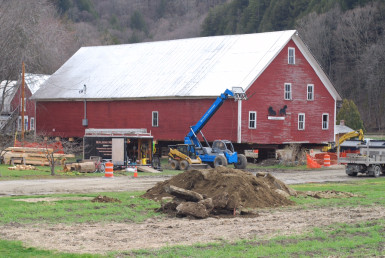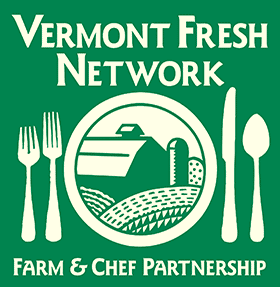Lareau Farm - Preserving History
 May 31, 2016
May 31, 2016
In Vermont, even the pizza is unique. George Schenk created American Flatbread, Vermont's pizza dynasty -- a concept so simple yet infused with the values we as Vermonters treasure. Now, with his Flatbread legacy firmly established, George is focusing on preserving his own slice of the Mad River Valley – the same place the pizza revolution started – Lareau Farm.
Lareau Farm is home to the Inn at Lareau Farm, the original American Flatbread restaurant, extensive organic gardens and a big red barn that dates back to 1794. Nestled at the base of Camels Hump in Waitsfield, the picturesque farm is reminiscent of classic Vermont – an image that resonated with George from when he’d explore the Northern Vermont countryside with his uncle. “We have a cultural identity in our historic barns,” Schenk shared, “and as the steward of Lareau Farms I have a responsibility.” That’s why, if you drive by Lareau Farms, you’ll see the historic barn sitting a foot off the ground. George, with the help of a team of architects, restoration specialists, and community volunteers has undertaken the restoration and preservation of the 200-year-old structure.
Renovating a historic building is no easy task, but it’s nothing compared to the way the barn was originally built in the 1700’s without any modern conveniences. “You grow a deeper appreciation for the craftsmanship and how much work the barn originally took to build,” George says, “and that makes it all the more important to conserve that work and legacy” The renovation has even unveiled some new information about the history of the barn and the early renovations and expansions it saw to accommodate a growing dairy industry. Eliot Lothrop of Building Heritage was especially excited to discover ‘marriage marks’ on the timbers, dating the original construction to the 18th century. Eliot described the unique markings as, “marks that were used to label two different timbers that have been uniquely cut to meet each other's individual shape, called "scribe rule" timber framing. This required the framers to lay all of the timbers out, one on top of the other -- incredibly labor intensive, heavy work. Around 1800, framers came up with the "square" rule method, which made the timbers more modular and independent from the timber that they were joining to. This meant that all of the timbers could be laid out and cut without regard for any other timbers joining them.” [You can see the marriage marks pictured here]
The renovation will take a break come July when the barn (set back down on the ground) will host its annual summer art shows for Valley Arts. The art shows, running through July and August, will be a perfect opportunity for visitors to come and see the project in works. George is restoring the barn so that it can continue to be a 3-season home to Valley Arts, as well as provide storage for the restaurant – he hopes this renovation will allow the barn to stand strong into the next century. Like the barn raisings of the past, it takes a village, and if you’d like to contribute to this project, you can donate directly or buy a commemorative t-shirt designed by George, himself!


